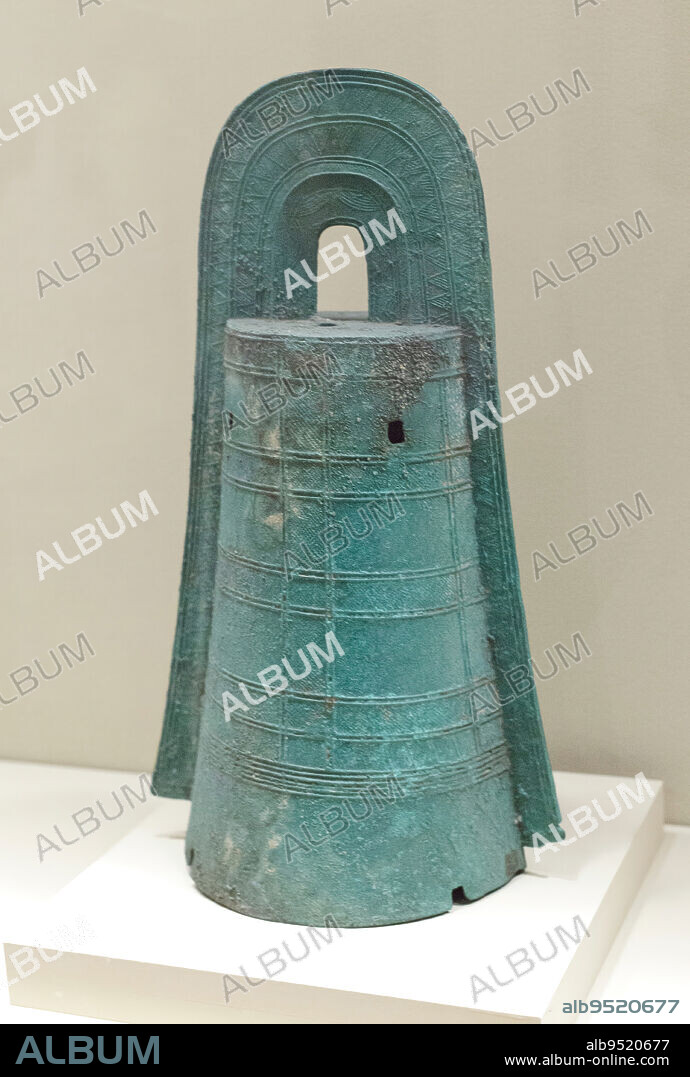alb9520677
Ritual Bell (Dtaku), 1st century BCE-1st century CE, Unknown Japanese, 8 x 10 in. (20.32 x 25.4 cm), Bronze, Japan, 1st century BCE - 1st century CE, Among the most impressive examples of early bronze casting in Japan are large, bronze bells like this one, known as dtaku. Metallurgy, together with wet-rice cultivation, was probably first introduced to Japan by a new wave of immigrants from the Korean peninsula around 200300 BCE. Although dtaku resemble Chinese bells in overall shape, most lack musical resonance because of the thinness of their casting. Instead, they seem to have been ritual objects and symbols of political authority. This bell was one of fourteen excavated in 1881 on Mount iwa in Shiga Prefecture.

|
Add to another lightbox |
|
Add to another lightbox |



Caption:
Ritual Bell (Dtaku), 1st century BCE-1st century CE, Unknown Japanese, 8 x 10 in. (20.32 x 25.4 cm), Bronze, Japan, 1st century BCE - 1st century CE, Among the most impressive examples of early bronze casting in Japan are large, bronze bells like this one, known as dtaku. Metallurgy, together with wet-rice cultivation, was probably first introduced to Japan by a new wave of immigrants from the Korean peninsula around 200300 BCE. Although dtaku resemble Chinese bells in overall shape, most lack musical resonance because of the thinness of their casting. Instead, they seem to have been ritual objects and symbols of political authority. This bell was one of fourteen excavated in 1881 on Mount iwa in Shiga Prefecture.
Personalities:
Credit:
Album / quintlox
Releases:
Model: No - Property: No
Rights questions?
Rights questions?
Image size:
3686 x 5467 px | 57.7 MB
Print size:
31.2 x 46.3 cm | 12.3 x 18.2 in (300 dpi)
Keywords:
1881 • 1ST CENTURY BCE-1ST CENTURY CE • 200300 BCE • ARTFORM: BRONZEWORK • BELL • BRONCE • BRONZE BELLS • BRONZE BRASS • BRONZE • BRONZES • CASTING • DTAKU RESEMBLE CHINESE BELLS • DTAKU • EARLY BRONZE CASTING • EMBLEM • FIRST INTRODUCED • FOURTEEN EXCAVATED • IMMIGRANTS • IMPRESSIVE EXAMPLES • INSTEAD • JAPAN • JAPANESE • KOREAN PENINSULA • LACK MUSICAL RESONANCE • LARGE • METALLURGY • MOUNT IWA • NEW WAVE • OVERALL SHAPE • POLITICAL AUTHORITY • RITUAL BELL • RITUAL OBJECTS • SHIGA PREFECTURE • SIMBOLOS • SYMBOL • THINNESS • TOGETHER • UNKNOWN JAPANESE • WET-RICE CULTIVATION
 Pinterest
Pinterest Twitter
Twitter Facebook
Facebook Copy link
Copy link Email
Email

